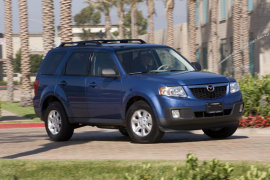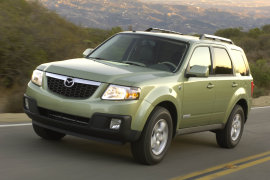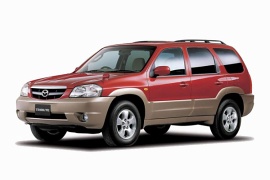MAZDA Tribute Models/Series Timeline, Specifications & Photos
First production year: 2001
Engines: Gasoline, Hybrid gasoline, Hybrid
Body style: SUV (Sports Utility Vehicle)
Mazda introduced an upgraded version of the Tribute's second generation in 2008 and gained a hybrid powertrain.
The car was less of a new generation since it was built on top of the same CD2 platform, but there were significant changes. Finally, the Japanese automaker was allowed by Ford to sell the hybrid version, which was previously available only for its siblings, the Escape and the Mercury Mariner.
Mazda already tried to create its own design language, and for specific vehicles, it did that successfully. Unfortunately, the Tribute had to stick to the car's main design cues since the SUV was assembled on the same production lines as its Ford and Mercury siblings. When it introduced the hybrid version for the 2009 model year in 2008, the automaker made only minimal changes to lower production costs.
On the exterior, the 2009 Tribute showed the same bodywork as the 2008 model-year vehicle that was introduced in 2007 at the Montreal International Auto Show. There was just a clue on the outside stating that it was an electrified version, and that was on the tailgate. There, Mazda placed the "Hybrid" word under the car's nameplate, and that was the only visible difference.
Inside, the automaker kept the same overall layout as on the non-hybrid version. Yet, it added an LCD on the center stack showing the hybrid system's status. In addition, it also told when the battery pack was charging and when it was helping push the car.
The hybrid drivetrain consisted of a 2.5-liter inline-four, running in Atkinson-cycle, helped by a 94-hp electric motor. Its battery pack was placed under the rear floor and was made using nickel-metal-hydride cells. Unfortunately, the fuel efficiency was not that great compared with its gasoline-only powered siblings.
Built together with Ford, which offered the same car under the Escape name, the second generation of the Mazda Tribute was introduced at the 2007 Montreal International Auto Show.
The marriage between Mazda and Ford was already gone, but they didn't know that when the car was developed. The world economic crisis was not started yet, but the financial advisors already had their red-flags up. But the car had to be launched and win some market before it was too late.
The Tribute featured a truck-like appearance even if it was not a body-on-frame construction as the Mazda Navajo/Ford Explorer duo. But it still resembled some of the design cues from that. The wide, V-shaped, grille with a chromed bar on top and the almost flat hood were part of the off-road design school. The raked C-pillar, behind the rear doors, resembled those found on regular sedans.
The interior featured high-quality materials and a car-like instrument cluster with two round dials. With the floor-mounted gear-stick and the center stack that hosted the CD-radio and the climate control unit, the Tribute was addressed to both sedan users an SUV-users. The rear bench was folding completely flat, with the headrests removed.
For the engine compartment, Mazda introduced some of its already known engine of 2- or 2.3-liter. A 3.0-liter V6 was available. The most fuel-efficient version announced was a hybrid with a 2.5-liter Atkinson cycle engine mated to an electric motor.
Sharing its platform with the Ford Escape, the smaller Tribute was well equipped and offered a roomy interior.
Available in three trim levels, the Tribute came with a front-wheel-drive or four-wheel drive system.
The base DX model was equipped with a rather underpowered engine that developed 130 hp, mated with a 5-speed manual transmission.
For an additional cost, the choice of a more powerful 200 hp V6 engine was available. The V6 unit was mated with a 4-speed automatic transmission as a single option.
The mid-range LX trim level, the Tribute was equipped with upgraded cloth upholstery, cruise control, fog lights, a cargo cover and a reclining, split-folding rear seat.
The top-of-the-range ES added leather upholstery and a power driver’s seat.
Offering room for 5, the Tribute offered a roomy interior for both the front and the rear passengers. However, two adults would be better than three in the back seats.
With the small-SUV market constantly increasing, the Tribute had strong competitors as the Honda CR-V, the Jeep Cherokke or the Nissan Xterra. However, the Tribute was a best seller with the most powerful V6 in its class and the spacious cabin.
Mazda’s aim was to built a sport-utility vehicle that would do more than just moving people from A to point B. The Tribute was a fun car to drive, providing good handling and a comfortable ride.


